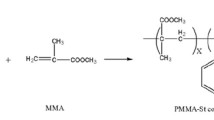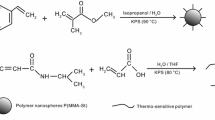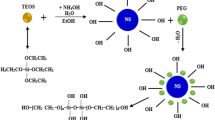Nanoplugging materials are used in drilling fluid systems to seal nanopores and cracks in the shale formation, which is a focus for developing shale gas. In this work, nanoparticles of the St-NaSS copolymer were synthesized by emulsion polymerization of styrene and styrene sulfonic acid sodium salt as monomers. The St-NaSS copolymer was characterized by FT-IR, TGA, and light scanning phase analysis. The results show that the grain size of the St-NaSS copolymer nanoparticles ranges from 37 to 50 nm, and the average diameter is about 43.2 nm. The decomposition temperature of the St-NaSS copolymer is 410.7°C, indicating that the material has good temperature resistance. The St-NaSS nanoparticles have little effect on the rheological properties of the water-based drilling fluid. The plugging performance of the St-NaSS nanoparticles was evaluated by the mud cake simulation method. The permeability of the mud cake is 3.32×10-5 μm2 which is close in value to that of the shale. When the drilling fluid contains 0.5 wt.% of St-NaSS nanoparticles, the plugging rate is 88.93%. The plugging rate of the mud cake increases with increase in the concentration of the St-NaSS nanoparticles. When the amount of rho St-NaSS nanoparticles is 1.0% the plugging effect of the drilling fluid is excellent. Therefore, St-NaSS copolymer nanoparticles can be successfully applied as a plugging agent to provide borehole stability in the shale formation.











Similar content being viewed by others
References
M. Melikoglu, “Shale gas: Analysis of its role in the global energy market,” Renew. Sustain. Energ. Rev., 37,460-468 (2014).
C. McGlade, J. Speirs, and S. Sorrell, “Unconventional gas - a review of regional and global resource estimates,” Energy, 55, 571-584 (2013).
M. Liang, H. Liang, J. Yuan, and Y. Fan, “Coalbed gas and shale gas resource prospect of Heyang-Hancheng area,” IOP Conference Series Earth and Environmental Science, 300, 022080 (2019).
H. Zhang, J. T. Shi, and X. F. Li, “Optimization of shale gas reservoir evaluation and assessment of shale gas resources in the Oriente basin in Ecuador,” Pet. Sci., 15, 756-771 (2018).
G Y. Mai, X. L. Chen, X. H. Xia, Z. Zhou, and R.H. Yuan, “The dynamic economic evaluation method of shale gas resources,” Chin. Geol., 2(2), 211-217 (2019).
X. Wang and R. Sterling, “Stability analysis of a borehole wall during horizontal directional drilling,” Tunnel. Undergr. Space Technol., 22, 620-632 (2007).
G Bol, S. W. Wong, C. Davidson, and D. Woodland, “Borehole stability in shales,” SPE Drill. Compl., 9, 87-94(1994).
M. Khodja, J. P. Canselier. F. Bergaya, R. Fourar, M. Rhodja, N. Cohaut and A. Benmounah, “Shale problems and water-based drilling fluid optimisation in the Hassi Messaoud Algerian oil field,” Appl Clay Sci., 49, 383-393 (2010).
J. D. Ytrehus, M. A. Taghipour, A. Golchin, A. Saasen, and B. Prakash, “The effect of different drilling fluids on mechanical friction,”J Energy Resour. Technol., 139(3), 502-508 (2017).
S. Ullah and N. Dhar, “Effects of vegetable oil based cutting fluid in machining kevlar composite material,” Am. J. Mech. Eng., 6(2), 54-60 (2018).
M.R. Chaudhury, “Spread the word about nanofluids,”Nature, 423, 131-132 (2003).
J. Cal, M. E. Chenevert, M. M. Sharma, and J. E. Friedheim, “Decreasing water invasion into Atoka shale using nonmodified silica nanopartkles,”SPE Drill. Complet., 27, 103-112 (2012).
D. V. Rosynkin, G. Ceriotti, R. C. Wilson, J. R. Lomeda, J. T. Scorsone, A. D. Patel, J. E. Friedheim, and J. M. Tour, “Graphene oxide as a high-performance fluid-loss-control additive in water-based drilling fluids,”ACS Appl. Mater. Interfaces, 4(1), 222-227 (2012).
M. C. Li, Q. Wu, K. Song. Y. Qing, and Y. Wu, “Cellulose nanoparticles as modifiers for theology and fluid loss in bentonite water-based fluids,” ACS Appl. Mater. Interfaces, 7, 5006-5016 (2015).
L. Ma, Y. He, P. Luo, L. Zhang, and Y. Yu, “Automatic dispersion, long-term stability of multi-walled carbon nanotubes in high concentration electrolytes,” J. Nanopart. Res., 20(2), 45-57 (2018).
G Xie, P. Luo, M. Deng, Z. Wang, and R. Gong, “Hyperbranched polyamine as nano-plugging agent used in water-based drilling fluid,”Nanosci. Nanotechnol. Lett., 9, 310-315 (2017).
Y. An, G Jiang, Y. Ken, L. Zhang, Y. Qi, and Q. Ge, “An environmental friendly and biodegradable shale inhibitor based on chitosan quaternary ammonium salt,”J. Pet. Sci. Engin., 135, 253-260 (2015).
D. Amnbabu, Z. Sanga, K. M. Seenimeera, and T. Jana, “Emulsion copolymerization of styrene and sodium styrene sulfonate: kinetics, monomer reactivity ratios and copolymer properties,” Polym. Int., 58(1). 88-96 (2009).
J. H. Kim. M. Chainey, M. S. El-Aasser, and J. W. Vanderhoft “Emulsifier-free emulsion copolymerization of styrene and sodium styrene sulfonate,” J. Polym. Sci. Part A: Polym. Chem., 30(2), 171-183 (1992).
D. Lin-Vien, N. B. Colthup, W. G Fateley, and J. G Grasselli, The Handbook of Infrared and Raman Characteristic Frequencies of Organic Molecules, Academic Press, New York (1991).
ACKNOWLEDGMENTS
This work was financially supported by the China Petrochemical Co. Ltd.’s major science and technology project “Shunbei Oil and Gas Field One Area Excellent Fast Drilling Technology Research" (P18021-2)
Author information
Authors and Affiliations
Corresponding author
Additional information
Translated from Khimiya i Tekhnologiya Topliv i Masel, No. 1, pp. 62-67, January —February, 2021.
Rights and permissions
About this article
Cite this article
Fang, J., Fan, L., Zhang, J. et al. The Blocking Properties of Styrene-Styrene Sulfonic Acid Sodium Salt Copolymer as a Nanodispersing Agent in Water-Based Drilling Fluids. Chem Technol Fuels Oils 57, 95–106 (2021). https://doi.org/10.1007/s10553-021-01230-1
Published:
Issue Date:
DOI: https://doi.org/10.1007/s10553-021-01230-1




